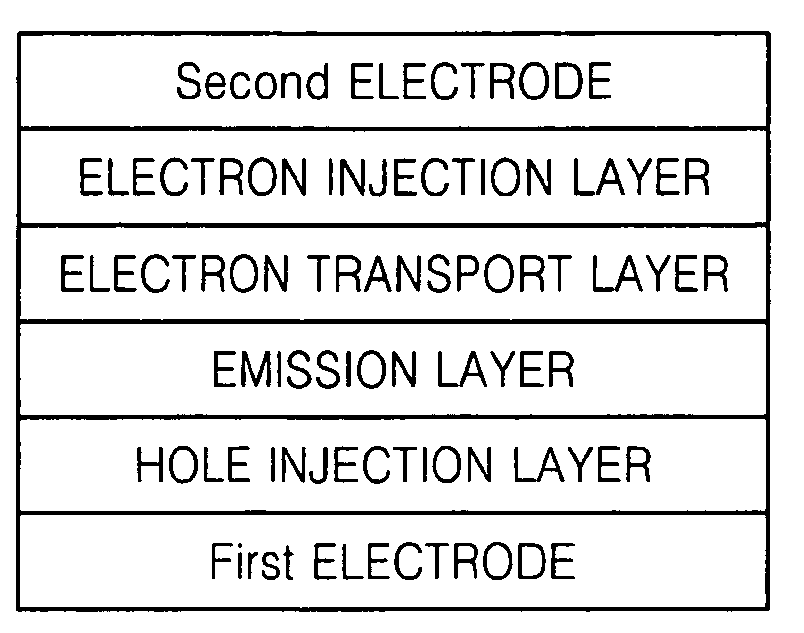Polymer organic light-emitting device
a light-emitting device and organic technology, applied in the direction of organic semiconductor devices, auxillary members of forms/shuttering/falseworks, discharge tubes luminescnet screens, etc., can solve the problems of reducing the number of holes that can be transported into the recombination zone, generating an insoluble layer, and reducing the recombination zone. , to achieve the effect of improving the properties of electron density, brightness, and color purity
- Summary
- Abstract
- Description
- Claims
- Application Information
AI Technical Summary
Benefits of technology
Problems solved by technology
Method used
Image
Examples
example 1
[0072]A polymer OLED having the following structure was manufactured using PVK as a dopant of an EML: ITO / (PEDOT:PSS) (50 nm) / Formula 2+PVK (70 nm) / BaF2 (4 nm) / Ca (2 nm) / Al (150 nm).
[0073]As an anode, a 15Ω / cm2 (1500 Å) ITO glass substrate from Corning Inc. was cut into pieces of 50 mm×0.7 mm, cleaned by ultrasonic agitation in a mixture of pure water and isopropyl alcohol for 5 minutes, and then was cleaned with UV radiation and O3 for 10 minutes before use. PEDOT:PSS was coated on the glass substrate and baked at 120° C. for 10 minutes to form a HTL having a thickness of 500 Å. Subsequently, Formula 2+PVK (prepared in a ratio of 1:1 by weight of Formula 2 to PVK) was spin-coated, and was heat-treated at 200° C. for 1 hour to form an EML having a thickness of 700 Å. Then, (BaF24 nm / Ca2 nm / Al150 nm cathode) was vacuum-deposited on the EML to manufacture the polymer OLED shown in FIG. 1D, which was designated sample A.
example 2
[0074]A polymer OLED was manufactured in the same method as described in Example 1 except that Formula 3+PVK, instead of Formula 2+PVK, was used to form an EML.
example 3
[0075]A polymer OLED was manufactured in the same method as described in Example 1 except that the EML included 0.1 weight % of PVK, which is a hole transport material, with respect to the total weight of the EML.
PUM
| Property | Measurement | Unit |
|---|---|---|
| Percent by mass | aaaaa | aaaaa |
| Percent by mass | aaaaa | aaaaa |
| Thickness | aaaaa | aaaaa |
Abstract
Description
Claims
Application Information
 Login to View More
Login to View More - Generate Ideas
- Intellectual Property
- Life Sciences
- Materials
- Tech Scout
- Unparalleled Data Quality
- Higher Quality Content
- 60% Fewer Hallucinations
Browse by: Latest US Patents, China's latest patents, Technical Efficacy Thesaurus, Application Domain, Technology Topic, Popular Technical Reports.
© 2025 PatSnap. All rights reserved.Legal|Privacy policy|Modern Slavery Act Transparency Statement|Sitemap|About US| Contact US: help@patsnap.com



